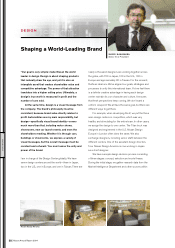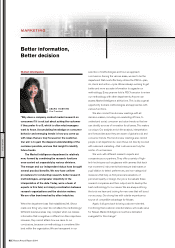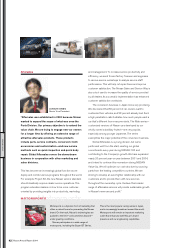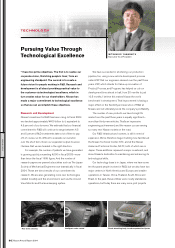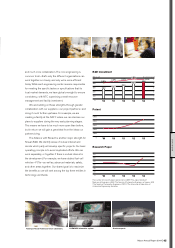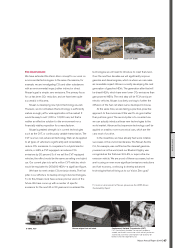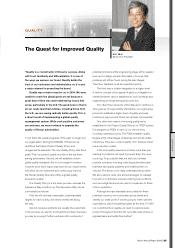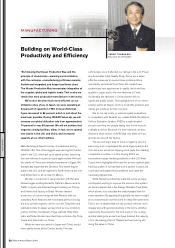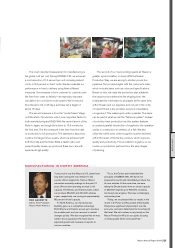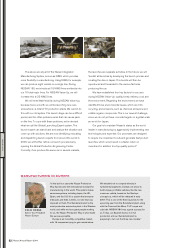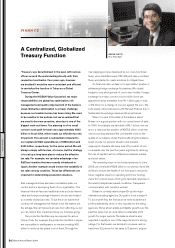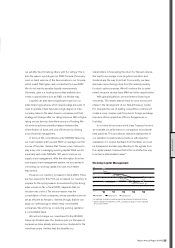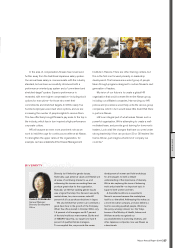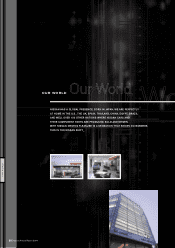Nissan 2005 Annual Report Download - page 50
Download and view the complete annual report
Please find page 50 of the 2005 Nissan annual report below. You can navigate through the pages in the report by either clicking on the pages listed below, or by using the keyword search tool below to find specific information within the annual report.
Nissan Annual Report 2004
48
Our Alliance with Renault has also provided substantial
purchasing benefits and opportunities. Formed in 2001, the
Renault Nissan Purchasing Organization, or RNPO, now
accounts for over 70 percent of all purchasing for Nissan
and Renault. Nissan will further benefit from RNPO through
the utilization of Renault supply bases in certain LCCs.
Although the turnaround in the Nissan business has
been profound, we also recognize that our supplier partners
have played a significant role. Going forward, we intend to
reinforce those relationships, building value on both sides.
For example, we are reinvigorating our innovative 3-3-3
engineering program.
We are also deploying a purchasing process that gets
suppliers involved earlier and further upstream in the
product development process, the concept of ‘project
partners’. This is a program that identifies key technologies
and innovations that require substantial investments from
both sides. Suppliers will be selected as project partners for
a specific area and will work closer with us to develop
lower cost and higher quality solutions. This win-win
approach has already started with interior systems and
chassis development projects.
Last year, we faced several challenges with raw
materials. Those risks—both price and supply related—are
a factor that we have to recognize and address in the
coming years. Last year, the pressure was concentrated on
the supply side, going forward we see an increasingly
challenging cost environment. Working closely with our key
raw material suppliers as well as parts suppliers and
accelerating our cost reduction countermeasures will be
key during NISSAN Value-Up.
Our purchasing philosophy at Nissan is focused on
value, quality and relationships. We want our purchasing
process to be transparent and proactive, and create more
value for our suppliers and for the company.”
PURCHASING
“The evolution that took place in Nissan’s purchasing
activities during the Nissan Revival Plan, or NRP, and
continued through NISSAN 180, will stretch even further
during NISSAN Value-Up. Why evolution and not
revolution? Because the shift in purchasing that started
six years ago was not a single action, it was a mindset
change that continues to drive all our activities.
Purchasing represents the single largest area of
cost for Nissan. Through the NISSAN Value-Up
business plan, we are determined to drive greater
value from our purchasing activities and maintain the
momentum built over the last six years.
During the Nissan Revival Plan years, our focus
was on catching up with the rest of the industry.
NISSAN 180 was focused on reaching the
benchmarks set during NRP and now as we enter the
NISSAN Value-Up period, that focus evolves towards
being the global cost leader.
One of the key breakthrough strategies of
NISSAN Value-Up is the focus on new and emerging
markets. On the sales side, markets like China, India,
Russia and ASEAN represent significant opportunities
for Nissan. On the purchasing side, we look at the
cost competitiveness of these new markets and how
we can increasingly use them to enhance our global
competitiveness.
Our strategy for what we call ‘Leading Competitive
Countries’, or LCCs, is to focus on those markets that we
see as trend leaders in both cost, quality and supply
stability. We will focus first on China and then on ASEAN
nations. This will bring cost advantages for our major
regions, such as Japan, North America and Western
Europe, making us more competitive. We’re also
investigating sourcing from Eastern Europe, the Mercosur
trading zone, and India.
More value, Higher quality,
Win-win partnerships HIROTO SAIKAWA
Executive Vice President
OUR WORK


